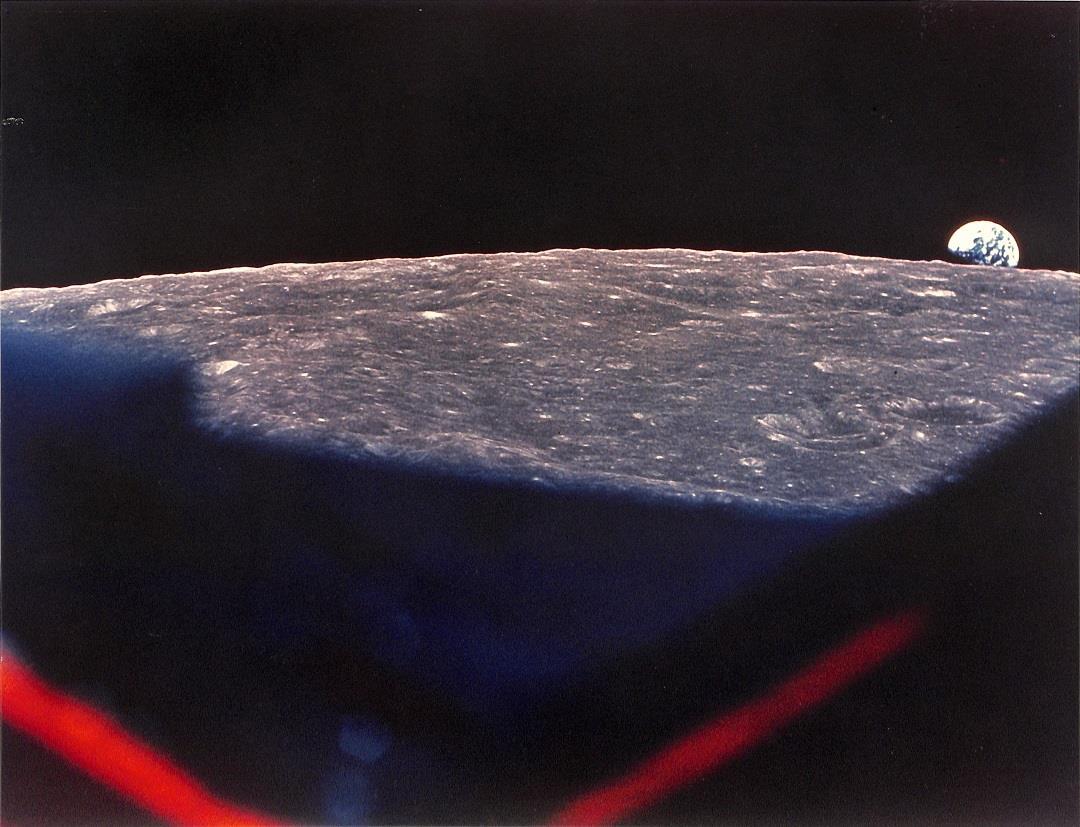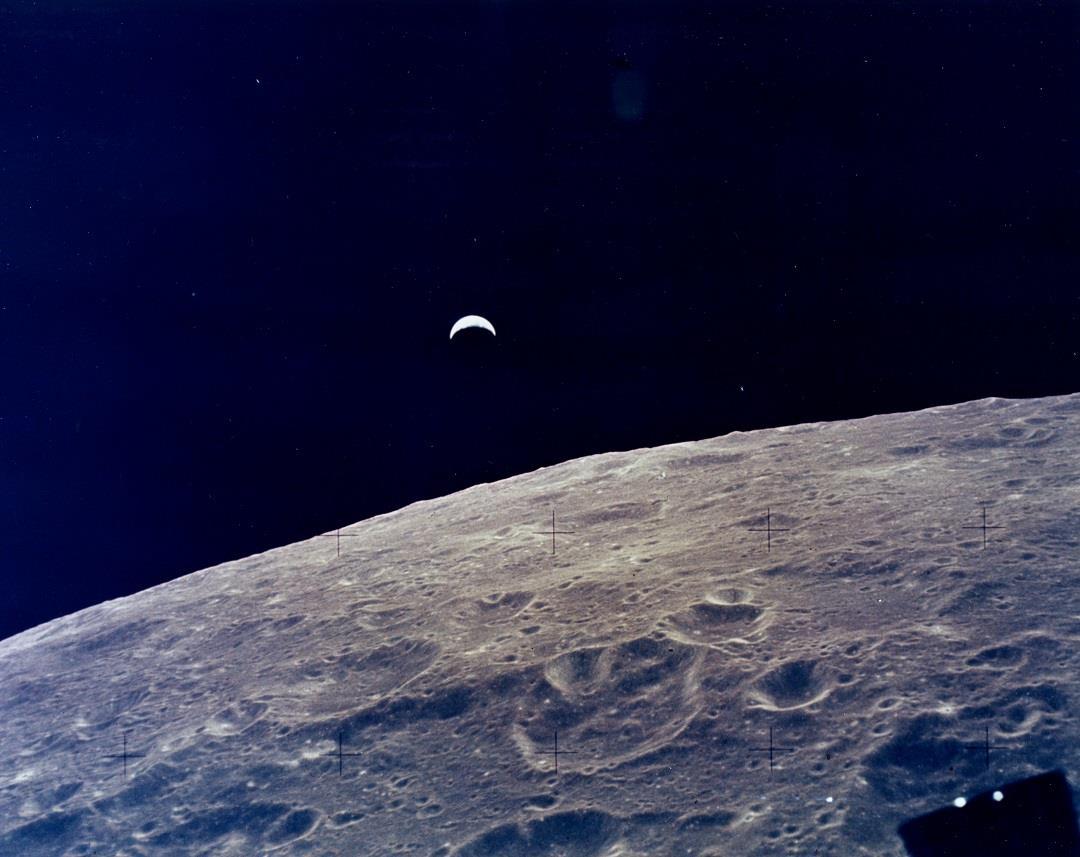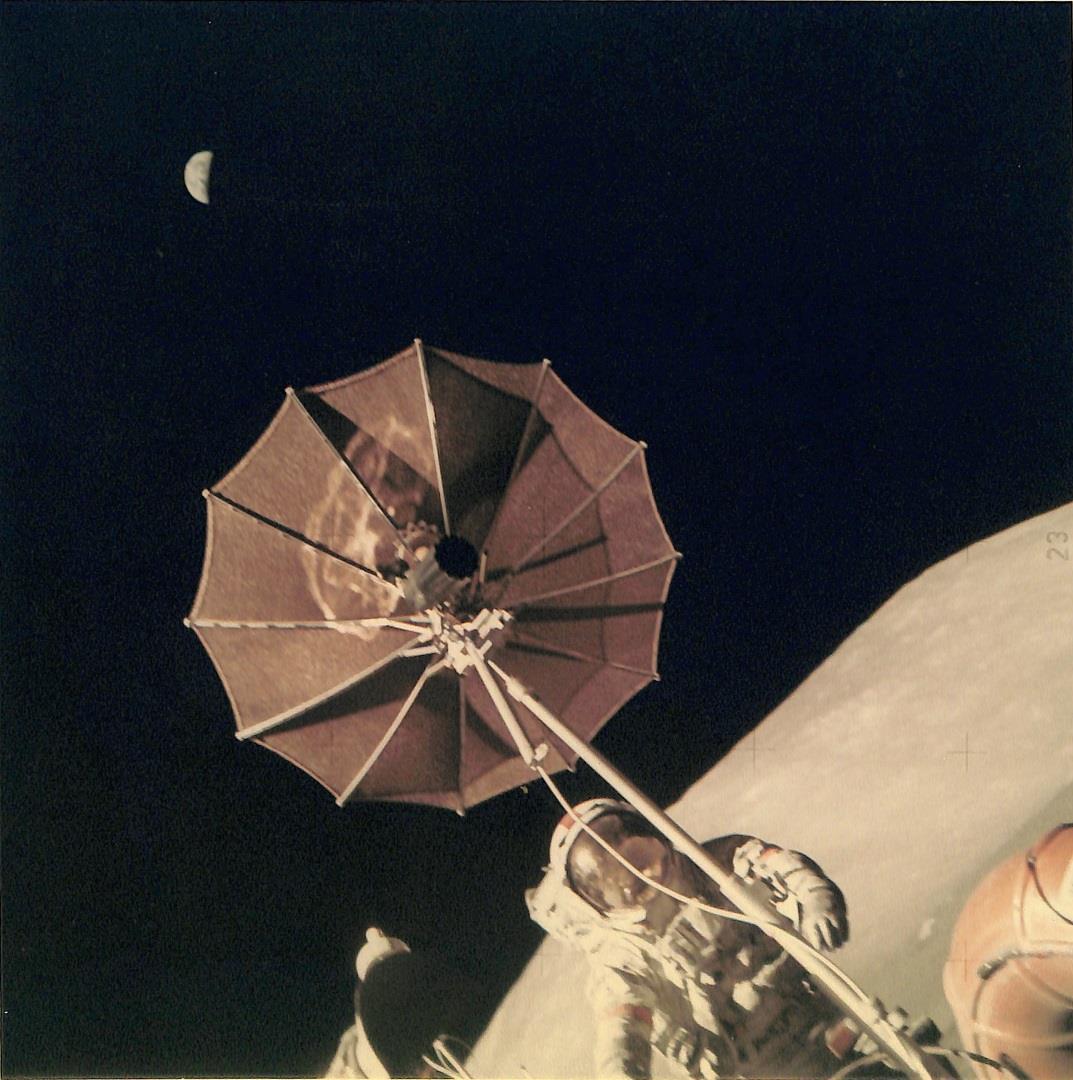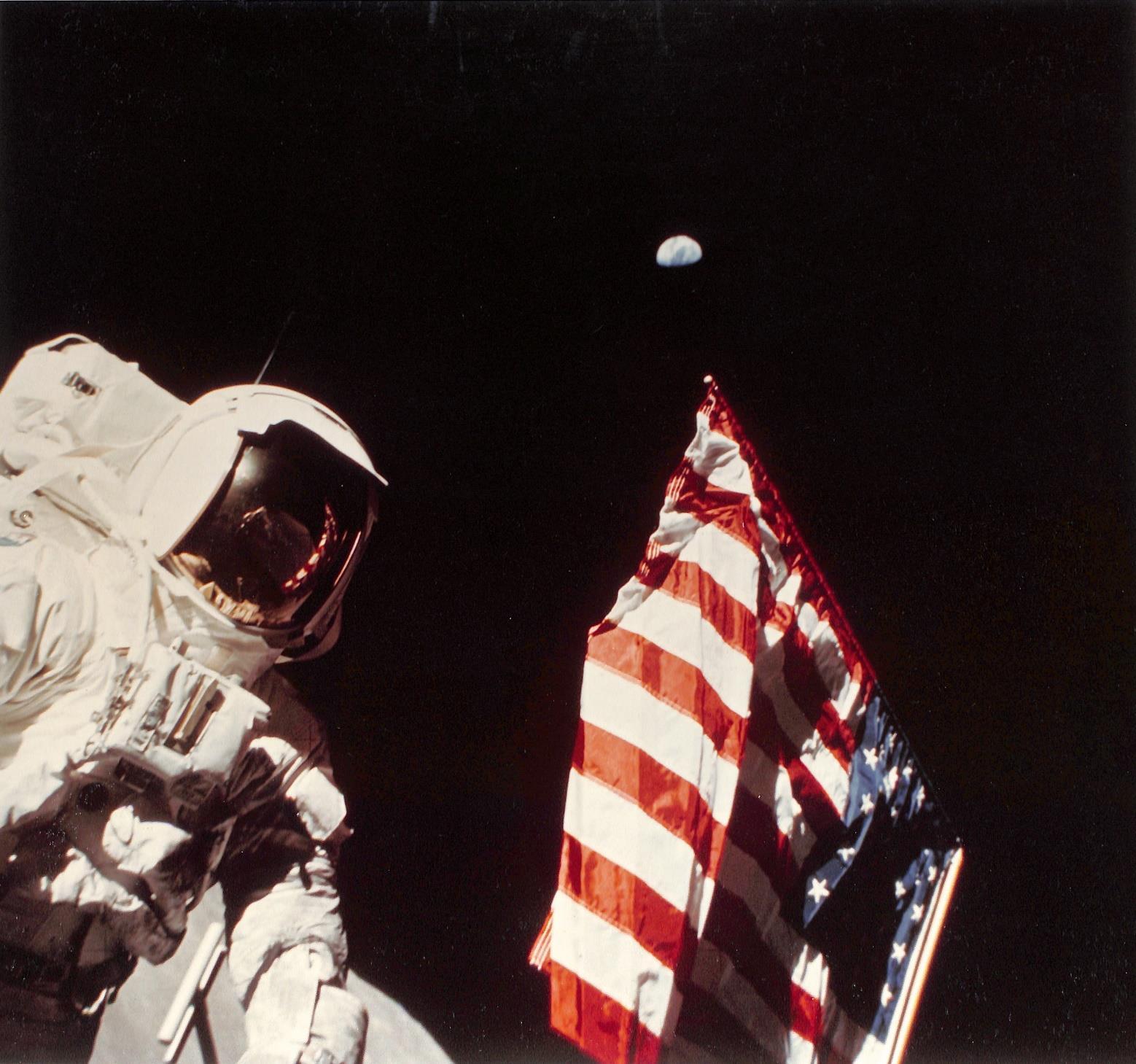

9March
9May2023
« Earthrise »
–
Galerie GADCOLLECTION
Catalogue réalisé à l’occasion de l’exposition

9 mars – 9 mai 2023
Les dimensions indiquées sont celles des tirages exposés.
The dimensions indicated are those of the paper of the prints
« Earthrise »
INTRODUCTION
The Apollo missions from 1968 to 1972 were a defining moment in human history, as they marked the first time that humans had journeyed to another celestial body. During these missions, the astronauts captured a number of stunning photographs of the Earth as seen from space, including several famous Earthrises. These images not only provided new perspectives on our planet, but also played a role in inspiring environmental and scientific awareness.
One of the most famous Earthrise images was captured during the Apollo 8 mission in 1968. This photograph showed the Earth as a blue and white orb, rising above the barren lunar landscape. The image was widely reproduced and became an iconic symbol of the space age. It not only inspired people to think about the Earth in a new way, but also served as a wake-up call to the need to protect and preserve our planet.
The Apollo 11 mission in 1969 was the first mission to successfully land humans on the moon. While the primary focus of this mission was the lunar landing, the astronauts also captured images of the Earth from the lunar surface. These images showed the Earth as a distant and fragile world, suspended in the blackness of space.
The Apollo 12 and Apollo 14 missions continued to bring back images of the Earth from space, each one offering new perspectives and insights into our planet. The Apollo 15 mission was the first to use the Lunar Roving Vehicle, allowing the astronauts to travel much further from the lunar module and capture even more spectacular images of the Earth.
The final Apollo missions, Apollo 16 and Apollo 17, continued to bring back remarkable images of the Earth, further strengthening the connection between space exploration and environmental awareness. These missions were a testament to human ingenuity and determination, and the images they captured of the Earth continue to inspire people to this day.
The Earthrise images captured during the Apollo missions were a defining moment in our understanding of the Earth and our place in the universe. They showed us the beauty and fragility of our planet, and served as a call to action to protect and preserve it. These images remain a powerful reminder of the connection between space exploration and environmental awareness, and continue to inspire future generations to strive for a better and more sustainable world.
Les missions Apollo de 1968 à 1972 ont été un moment déterminant dans l'histoire de l'humanité, car elles ont marqué la première fois que des humains se sont rendus dans un autre corps céleste. Au cours de ces missions, les astronautes ont capturé un certain nombre de photographies époustouflantes de la Terre vue de l'espace, y compris plusieurs célèbres Earthrise. Ces images ont non seulement fourni de nouvelles perspectives sur notre planète, mais ont également joué un rôle dans la prise de conscience environnementale et scientifique.
L'une des images Earthrise les plus célèbres a été capturée lors de la mission Apollo 8 en 1968. Cette photographie montrait la Terre sous la forme d'un orbe bleu et blanc, s'élevant au-dessus du paysage lunaire aride. L'image a été largement reproduite et est devenue un symbole emblématique de l'ère spatiale. Cela a non seulement inspiré les gens à penser à la Terre d'une manière nouvelle, mais a également servi de rappel à la nécessité de protéger et de préserver notre planète.
La mission Apollo 11 en 1969 a été la première mission à faire atterrir avec succès des humains sur la lune. Alors que l'objectif principal de cette mission était l'atterrissage lunaire, les astronautes ont également capturé des images de la Terre depuis la surface lunaire. Ces images montraient la Terre comme un monde lointain et fragile, suspendu dans la noirceur de l'espace.
Les missions Apollo 12 et Apollo 14 ont continué à rapporter des images de la Terre depuis l'espace, chacune offrant de nouvelles perspectives et un aperçu de notre planète.
La mission Apollo 15 a été la première à utiliser le Lunar Roving Vehicle, permettant aux astronautes de voyager beaucoup plus loin du module lunaire et de capturer des images encore plus spectaculaires de la Terre.
Les dernières missions Apollo, Apollo 16 et Apollo 17, ont continué à rapporter des images remarquables de la Terre, renforçant encore le lien entre l'exploration spatiale et la conscience environnementale. Ces missions ont témoigné de l'ingéniosité et de la détermination humaines, et les images qu'elles ont capturées de la Terre continuent d'inspirer les gens à ce jour.
Les images Earthrise capturées lors des missions Apollo ont été un moment déterminant dans notre compréhension de la Terre et de notre place dans l'univers. Ils nous ont montré la beauté et la fragilité de notre planète, et ont servi d'appel à l'action pour la protéger et la préserver. Ces images restent un rappel puissant du lien entre l'exploration spatiale et la sensibilisation à l'environnement, et continuent d'inspirer les générations futures à lutter pour un monde meilleur et plus durable.
NASA - Apollo 4
AS4-1-200

Earth View
9 November 1967
Original photography
Vintage Chromogenic Print on 'A Kodak Paper'
25,4 x 20,32 cm / 10 x 8 inch
Coastal Brazil, Atlantic Ocean, West Africa, Sahara, looking northwest, as photographed from the unmanned Apollo 4 earth-orbital space mission. This picture was taken when the Spacecraft 017 and the Saturn IVB stage were orbiting Earth at an altitude of 9,060 nautical miles.
Se renseigner

NASA - Apollo 8
AS8-14-2383
Earthrise
24 December 1968
Original photography
Vintage Chromogenic Print on 'A Kodak Paper'
25,4 x 20,32 cm / 10 x 8 inch
William Anders
The first human-taken color photograph of Earthrise

Se renseigner

NASA - Apollo 8
AS8-14-2383 | Red Tab Number

Earthrise
24 December 1968
Original photography
Signed by Frank Borman
Vintage Chromogenic Print
‘This Paper manufactured by Kodak’
25,4 x 20,32 cm / 10 x 8 inch
William Anders
The first human-taken color photograph of Earthrise
Se renseigner

NASA - Apollo 8
AS8-14-2383
Earthrise
24 December 1968
Original photography
Vintage Chromogenic Print on 'A Kodak Paper'
25,4 x 20,32 cm / 10 x 8 inch
William Anders
The first human-taken color photograph of Earthrise

Se renseigner

NASA - Apollo 8
AS8-14-2392
Earthrise
24 December 1968
[Large Format]
Original photography
Vintage Chromogenic Print
Mounted on board
40,5 x 51cm / 16 x 20 inch
Image : 27 x 34,5 cm
William Anders
Se renseigner

High-oblique view of the moon's surface showing Earth rising above the lunar horizon, looking west-southwest, as photographed from the Apollo 8 spacecraft as it orbited the moon. The center of the picture is located at about 105 degrees east longitude and 13 degrees south latitude.

NASA - Apollo 8
AS08-16-2593

Earth View
22 December 1968
Original photography
Vintage Chromogenic Print
25,4 x 20,32 cm / 10 x 8 inch
William Anders
Se renseigner
One of the first images taken by humans of the whole Earth.
Photographed by the crew of Apollo 8 (probably by Bill Anders) the photo shows the Earth at a distance of about 30,000 km.

NASA - Apollo 8
AS08-16-2593

Earth View
22 December 1968
Original photography
Vintage Chromogenic Print
25,4 x 20,32 cm / 10 x 8 inch
Se renseigner
A striking view from the Apollo 8 spacecraft showing nearly the entire Western Hemisphere, from the mouth of the St. Lawrence River, including nearby Newfoundland, extending to Tierra del Fuego at the southern tip of South America. Central America is clearly outlined. Nearly all of South America is covered by clouds, except the high Andes Mountain chain along the west coast. A small portion of the bulge of west Africa shows along the sunset terminator.
 William Anders
William Anders
NASA - Apollo 8
AS08-16-2593

Earth View
22 December 1968
[Large Format]
Original photography
Vintage Chromogenic Print
30 x 38 cm / 11,75 x 15 inch
William Anders
Se renseigner
One of the first images taken by humans of the whole Earth.
Photographed by the crew of Apollo 8 (probably by Bill Anders) the photo shows the Earth at a distance of about 30,000 km.

NASA - Apollo 10

AS10-27-3980
Earth View
18 – 26 May 1969

[Large Format]
Original photography
Vintage Chromogenic Print
On ‘A Kodak Paper-Canvas’
28 x 35,5 cm / 11 x 14 inch
Image : 28 x 35 cm
Extremely rare – This kind of paper was only used by the NASA officials for their personal use.
Se renseigner
NASA - Apollo 11
AS11-44-6642 | Red Tab Number

Earthrise
21 July 1969
Original photography
Vintage Chromogenic Print on 'A Kodak Paper'
25,4 x 20,32 cm / 10 x 8 inch
Michael Collins took this photo. View of the Moon limb, Lunar Module during ascent, Mare Smythii. Earth is visible over the horizon.

In this photo, there is all of humanity except one person: the photographer !
Se renseigner
NASA - Apollo 11
AS11-36-5355
Earth view
17 July 1969
[Large Format]
Original photography
Vintage Chromogenic Print on 'A Kodak Paper’
35 x 27 cm / 13,75 x 10,6 inch
Most of Africa, Middle-East and portions of Europe and Asia can be seen in this spectacular photograph taken from the Apollo 11 spacecraft during its trans-lunar coast toward the moon. Apollo 11, with astronauts Neil A. Armstrong, commander; Michael Collins, command module pilot; and Edwin E. Aldrin Jr., lunar module pilot, onboard was already 98,000 nautical miles from Earth when this picture was made. While astronauts Armstrong and Aldrin descended in the Lunar Module (LM) "Eagle" to explore the Sea of Tranquility region of the moon, astronaut Collins remained with the Command and Service Modules (CSM) "Columbia" in lunar orbit.

Se renseigner

NASA - Apollo 12
AS12-47-6874
Earthrise
19 November 1969

Original photography
Vintage Chromogenic Print on 'A Kodak Paper'
25,4 x 20,32 cm / 10 x 8 inch
Crescent Earth from lunar orbit. Crater Debus is in the center of the foreground. Prior to the landing.
 Se renseigner
Se renseigner
NASA - Apollo 16
AS16-113-18289
Earthrise
20 April 1972
Original photography
Vintage Chromogenic Print on 'A Kodak Paper'
25,4 x 20,32 cm / 10 x 8 inch
Earth rises over the lunar horizon, with the Apollo 16 Command and Services Modules (CSM) to the left of Earth. This photograph was taken from the Lunar Module (LM) "Orion" before the two Apollo 16 spacecraft re-joined following the CSM's failure to make the circularization burn on April 20, 1972. Astronaut Thomas K. Mattingly II, command module pilot, was inside the CSM "Casper", while astronauts John W. Young, commander, and Charles M. Duke Jr., lunar module pilot, were manning the LM. While astronauts Young and Duke descended in the LM to explore the Descartes region of the moon, astronaut Mattingly remained with the CSM in lunar orbit.

In this photo, there is all of humanity except one person: the photographer !
Se renseigner

NASA - Apollo 17
AS17-134-20473
Earthrise | Red Tab Number

13 December1972
Original photography
Vintage Chromogenic Print on 'A Kodak Paper'
25,4 x 20,32 cm / 10 x 8 inch
Earth appears in the far distant background above the hi-gain antenna of the Lunar Roving Vehicle in this photograph taken by scientist-astronaut Harrison H. Schmitt during the third Apollo 17 extravehicular activity (EVA) at the Taurus-Littrow landing site. Astronaut Eugene A. Cernan, Apollo 17 commander, stands beside the LRV. Schmitt is the mission's lunar module pilot. While Cernan and Schmitt descended in the lunar module "Challenger" to explore the moon, astronaut Ronald E. Evans, command module pilot, remained with the Command and Service Modules in lunar orbit.
Se renseigner

NASA - Apollo 17
AS17-134-20384
Earthrise
12 December 1972
[Large Format]
Original photography
Vintage Chromogenic Print
Matted on board
41 x 51 cm / 16 x 20 inch
Image : 26,6 x 29,2 cm / 10,5 x 11,5 inch
Scientist-astronaut Harrison H. Schmitt, lunar module pilot, is photographed next to the deployed United States flag during lunar surface extravehicular activity (EVA) at the Taurus-Littrow landing site.

The highest part of the flag appears to point toward our planet Earth in the distant background. This picture was taken by astronaut Eugene A. Cernan, Apollo 17 commander.
While astronauts Cernan and Schmitt descended in the Lunar Module (LM) to explore the moon, astronaut Ronald E. Evans, command module pilot, remained with the Command and Service Modules (CSM) in lunar orbit.
Se renseigner

NASA - Apollo 17

AS17-134-20384
Earthrise | Red Tab Number

12 December 1972
Original photography
Vintage Chromogenic Print on 'A Kodak Paper'
25,4 x 20,32 cm / 10 x 8 inch
Se renseigner
NASA - Apollo 17

AS17-134-20384
Earthrise | Black Tab Number

12 December 1972
Original photography
Vintage Gelatin Silver Print on 'A Kodak Paper'
25,4 x 20,32 cm / 10 x 8 inch
Se renseigner
NASA - Goddard - Apollo 17
AS17-137-20910
Earthrise
19 December 1972
Original photography
Vintage Chromogenic Print on 'A Kodak Paper'
25,4 x 20,32 cm / 10 x 8 inch
Earth (far distant background) is seen above a large lunar boulder (foreground) on the moon. The photo was taken with a handheld Hasselblad camera by the last two moon walkers in the Apollo Program.

Se renseigner

NASA - Apollo 17
AS17-152-23274
Earthrise
December 1972
Original photography
Vintage Chromogenic Print on 'A Kodak Paper'
25,4 x 20,32 cm / 10 x 8 inch
The crescent Earth rises above the lunar horizon in this spectacular photograph taken from the Apollo 17 spacecraft in lunar orbit during NASA final lunar landing mission in the Apollo program.
View of the crescent Earth rising above the lunar horizon over the Ritz Crater. Image taken during the Apollo 17 mission on Revolution 66.

Se renseigner



Galerie GADCOLLECTION 4 Rue du Pont Louis-Philippe 75004 PARIS +33 (0) 1 43 70 72 59 info@gadcollection.com Jours d'ouverture - Opening days Mardi au Vendredi : 14h00 - 19h00 Samedi et Dimanche : 14h30 - 19h00 Tuesday to Friday : 2 pm - 7 pm Saturday and Sunday : 2.30 - 7 pm https://www.gadcollection.com










 William Anders
William Anders




 Se renseigner
Se renseigner











